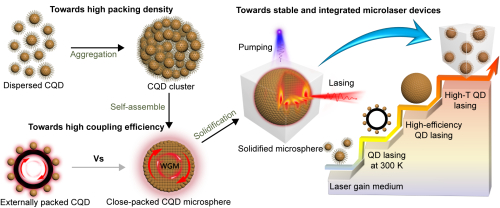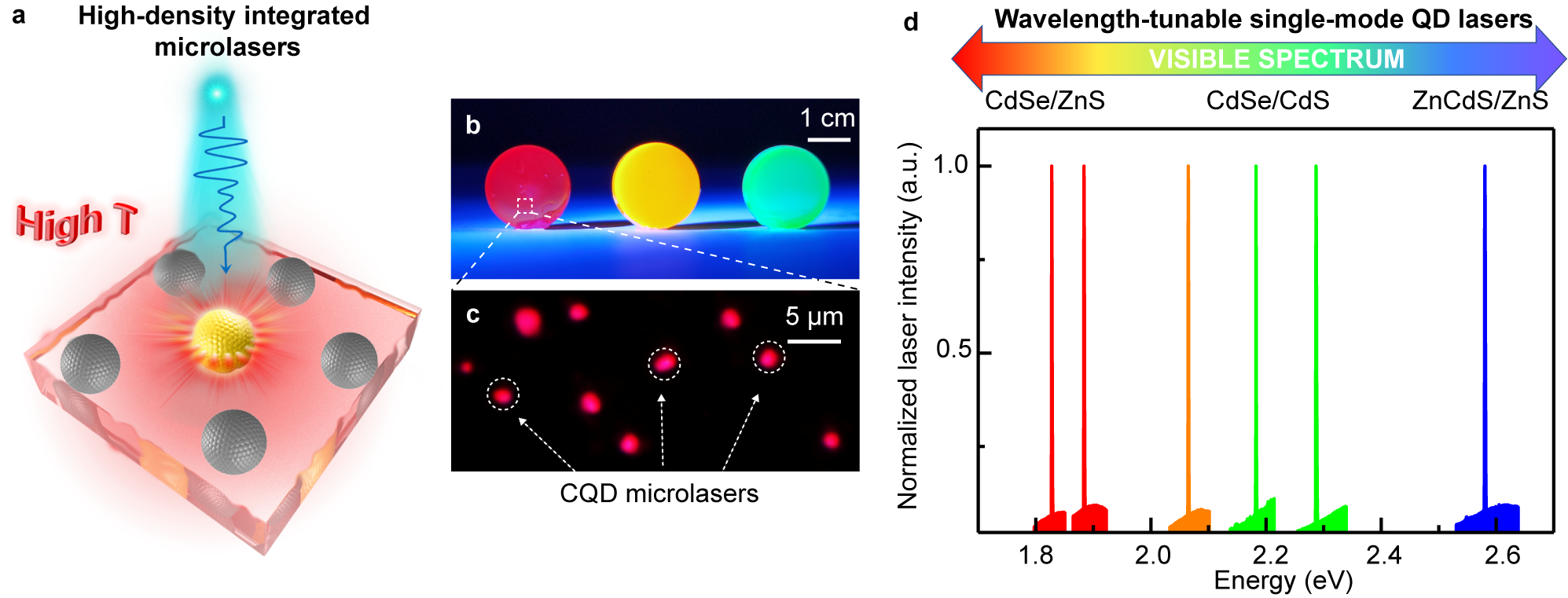Chinese researchers have invented a high-efficiency ultrastable low-cost colloidal quantum dots (CQDs) microlasers, which can be operated even at 450 K, and this is the highest operational temperature for CQDs lasers.
The achievement is noteworthy because microlasers, as multifunctional optical source components, are of great importance for optoelectronic devices, and motivation to realize high-performance high-temperature stable micro-/nanolasers have been a driving force for more than three decades.
CQDs microlasers are an important research focus because of their extraordinary temperature-insensitive optical properties and low-cost preparation processes.
The research was led by ZHANG Long and DONG Hongxing from Shanghai Institute of Optics and Fine Mechanics (SIOM) of the Chinese Academy of Sciences. Results were published in Light: Science & Applications on 18 March 2021.
“The low packing density, inefficient coupling of CQDs with optical cavities, and the poor thermal stability of miniaturized complex systems make it challenging to achieve practical CQDs micro-/nanolasers, especially to combine the continuous working ability at high temperatures and the low-cost potential with mass-produced synthesis technologies.” said DONG Hongxing, corresponding author of the paper. “How to solve above key problems efficiently needs to new ideas different from the traditional CQDs laser research.”
Researchers developed a novel assembly technique combined with the sol-gel method to fabricate CQD-assembled microspheres (CQDAMs) solidified in a silica matrix.
The new design material structure system not only guarantees that the CQDAMs work stably at high temperatures but also solves the problems of gain packing density and coupling efficiency.
DONG noted that “Heat dissipation problem is an intrinsic and inevitable difficulty for the next generation of highly-integrated optoelectronic devices. Our work contributes a direct solution by achieving the stable high-temperature operation ability for the miniaturized components.”
“This innovative solution-processable method does not require complex optical cavity processing, which is easy to operate, controllable, and easily mass-produced. CQDs microlasers can be highly integrated in a micro-substrate, promising for ultra-bright economical on-chip light sources.” DONG added.
“We find a unique way to break through the predicament of the CQDs laser research, and substantively promote its development stage from the basal performance study to the senior practical compatibility for high-temperature low-cost microlasers and the predictable commercialization.” Dong concluded.
This work was supported by the National Natural Science Foundation of China, the Natural Science Foundation of Shanghai, and the Key Program of the Hunan Provincial Science and Technology Department.

Fig. 1. The three core problems of CQD laser research and the corresponding solutions for achieving high-temperature CQD lasers. (Image by SIOM)

Fig. 2. High-density integrated lasers and broad wavelength-tunable single-mode lasers at high temperature based on CQDAMs. (Image by SIOM)
Article website:
https://doi.org/10.1038/s41377-021-00508-7
Contact:
WU Xiufeng
General Administrative Office
Shanghai Institute of Optics and Fine Mechanics, CAS
Email: xfwu@siom.ac.cn
Web: http://english.siom.cas.cn/